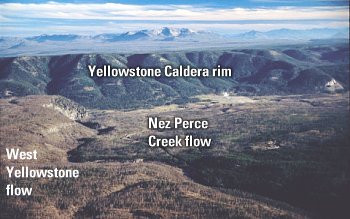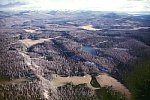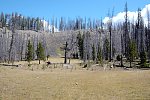Comparison of the three ash-flow tuffs of the Yellowstone Group and resulting calderas
Comparison of the three ash-flow tuffs of the Yellowstone Group and resulting calderas
| Lava Creek Tuff |
- 0.640 |
1,000 |
7,500 |
85 x 45 |
Yellowstone caldera |
| Mesa Falls Tuff |
-1.3 |
280 |
2,700 |
16 km in diameter |
Henry's Fork caldera |
| Huckleberry Ridge Tuff |
-2.1 |
2,450 |
15,500 |
75-95 x 40-601 |
Big Bend Ridge, Snake River,
and Red Mountains caldera segments |
1Inferred first-cycle caldera boundary is irregular; caldera
consists of three overlapping collapse areas.
Rim of the Yellowstone caldera (the youngest caldera)
|

Photograph courtesy of
Bob Smith, University of Utah
|
Aerial view of the striking NW rim of the Yellowstone caldera and
intracaldera rhyolite lava
flows at Madison Junction in Yellowstone National Park. View is looking
north. The steep-facing caldera wall, 500 m tall, formed when the
area in the foreground collapsed during eruption of the Lava
Creek Tuff 640,000 years ago. The thick West Yellowstone rhyolite lava
flow erupted about 110,000 years ago, and the Nez Perce Creek flow
erupted 160,000 years ago.
|
| |

Faults associated with
the NE
margin of Yellowstone caldera

Outermost fault
associated with the NE
margin of the Yellowstone caldera
|
These views of faults outside the caldera rim illustrate that
faults related to regional tectonic stresses can be associated with
caldera collapse along a zone of concentric ring faults. Click
on images for a description and larger-sized images.
Photographs courtesy of Bob Smith, University of
Utah
|




